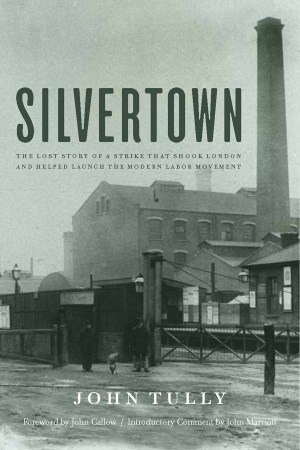Exclusive excerpt from John Tully's 'Silvertown: The Lost Story of a Strike that ... Helped Launch the Modern Labor Movement'
February 9, 2014 – Links International Journal of Socialist Renewal -- The following is an excerpt from John Tully's new book, Silvertown: The Lost Story of a Strike that Shook London and Helped Launch the Modern Labor Movement, published by Monthly Review Press. It is posted with the kind permission of Monthly Review Press. Readers of Links international Journal of Socialist Renewal are urged to order a copy HERE. You can download the excerpt HERE (PDF), or read it on screen below.
* * *
“This is a revolt against oppression: a protest against the brute force which keeps a huge population down in the depths of the most dire degradation, for the benefit of a knot of profit-hunters … this is a strike of the poor against the rich.”—William Morris, 1889
In 1889, Samuel Winkworth Silver’s rubber and electrical factory was the site of a massive workers' revolt that upended the London industrial district that bore his name: Silvertown. Once referred to as the “Abyss” by Jack London, Silvertown was notorious for oppressive working conditions and the relentless grind of production suffered by its largely unorganised, unskilled workers.
These workers, fed-up with their lot and long ignored by traditional craft unions, aligned themselves with the socialist-led “New Unionism” movement. Their ensuing strike paralysed Silvertown for three months. The strike leaders – including Tom Mann, Ben Tillett, Eleanor Marx and Will Thorne—and many workers viewed the trade union struggle as part of a bigger fight for a “co-operative commonwealth”. With this goal in mind, they shut down Silvertown and, in the process, helped to launch a more radical, modern labour movement.
Historian and novelist John Tully, author of the monumental social history of the rubber industry The Devil’s Milk: a social history of rubber (click HERE for an excerpt), tells the story of the Silvertown strike in vivid prose. He rescues the uprising—overshadowed by other strikes during this period—from relative obscurity and argues for its significance to both the labour and socialist movements. And, perhaps most importantly, Tully presents the Silvertown Strike as a source of inspiration for today’s workers, in London and around the world, who continue to struggle for better workplaces and the vision of a “co-operative commonwealth”.
The workers of London’s infamous Victorian East End have been the subject of much scrutiny, a good deal of it condescending. John Tully shows us how meticulous research and empathy for the dispossessed can recreate a past that is either forgotten or reduced to the forlorn. By taking us into the class struggle soul of a little-remembered 1889 strike at the Silvertown rubber works, Tully adds immeasurably to our understanding of the "new unionism" of the Victorian era. Through writing as impassioned as it is reasoned, Tully brings to life ‘the people of the abyss’ at one of their finest hours, in which the solidarity of the "outcasts" proclaims the possibility of "a better world in birth". This is history at its best: rigorous in its use of sources and capacities to broaden our ways of seeing experience; analytically demanding in the ways it pushes us to rethink conventional wisdoms of all kinds; and imaginative in the range of its argumentation. —Bryan D. Palmer, Canada research chair, Trent University; author of James P. Cannon and the Origins of the American Revolutionary Left and Revolutionary Teamsters: The Minneapolis Truckers’ Strikes of 1934
A major contribution to labor history and to the history of East London. Its detailed examination of a single, lengthy, and unsuccessful strike in 1889 in a large Silvertown rubber and gutta percha factory throws important new light on the development of the New Unionism in Britain and its relationship with the "aristocracy of labour".’ It is a serious and scholarly work written not with the usual academic detachment, but with a profound and moving feeling of empathy for the dispossessed and the exploited. It is recommended reading not only to historians and those concerned with East London, but as an inspiration to all those participating in today’s urgent struggle against increasing social and economic injustice. —Alvaro de Miranda, London East Research Institute, University of East London
John Tully’s excellent Silvertown book has again prised wide open a window onto an important but almost forgotten episode of working class history. Tully depicts vividly how men and women, many coming from rural parts of Britain and Ireland, suffered and united together in the new industrial expansion. Mud, community, fumes and struggle. His descriptions and analysis will be useful and enjoyable for activists and academics alike. —Oliver New, tube train driver and senior representative, National Union of Rail, Maritime and Transport Workers (RMT)
In his preface the author expresses the hope that he has been able to tell adequately the story of the Silvertown strikers. Few reading this passionate and lively account can doubt that he has succeeded. —John Marriott, emeritus professor of history, University of East London and author of Beyond the Tower
* * *
John Tully is lecturer in politics and history at Victoria University in Melbourne, Australia. He is author of The Devil’s Milk: A Social History of Rubber, as well as Cambodia Under the Tricolour: King Sisowath and the "Mission Civilisatrice", 1904-1927; France on the Mekong: A History of the Protectorate in Cambodia, 1863-1953; A Short History of Cambodia: From Empire to Survival; and two novels, Dark Clouds on the Mountain and Death Is the Cool Night.
Readers of Links international Journal of Socialist Renewal are urged to order a copy HERE. You can download the excerpt HERE (PDF), or read it on screen below.
Exclusive excerpt John Tully's "Silvertown: The Lost Story of a Strike that ... Helped Launch the...

